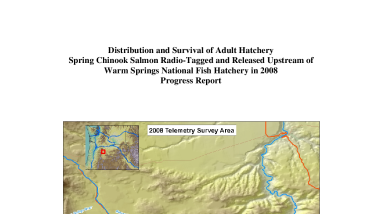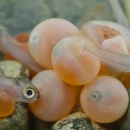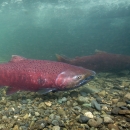The Warm Springs River supports the largest population of wild spring Chinook salmon Oncorhynchus tshawytscha in the Deschutes River Basin. Located on the Warm Springs River in north-central Oregon, the Warm Springs National Fish Hatchery was constructed in 1978 and produces spring Chinook salmon for sport and tribal harvests. Current hatchery practices intend to minimize disturbance to upstream wild fish populations by limiting the number of hatchery fish passed upstream. Concerns over the low numbers of wild fish returns, increasing pre-spawning mortality, and significant reductions in wild genetic integration into hatchery broodstock broodstock
The reproductively mature adults in a population that breed (or spawn) and produce more individuals (offspring or progeny).
Learn more about broodstock have led to inquiry over the fate of spring Chinook salmon passed above Warm Springs National Fish Hatchery. Increasing the number of hatchery fish allowed upstream of the hatchery has been suggested as a potential management action to compensate for the low wild fish numbers. The ecological and genetic consequences of this potential management action are currently unknown. To gain further insight on these management concerns, 35 hatchery-origin spring Chinook salmon were radio-tagged during the spring and summer of 2008 and released upstream of the hatchery to study their movement patterns, identify potential holding areas, estimate survival, and approximate their contribution to spawning. During the duration of the study, 45% of the radio-tagged fish migrated downstream of the hatchery and seven fall-back fish were recovered at the hatchery; however the majority of downstream migrants remained downriver. Based on tag movements during the spawning period, an estimated 60% of the tagged fish survived to spawning. Additionally, an estimated 31% of the radio-tagged hatchery fish contributed to natural spawning based on tag movement distance and location on traditional spawning grounds during the spawning period. The distribution of hatchery fish during spawning differed from the natural distribution of redds both within year, and historically. This report summarizes the first year of a multiyear study conducted by the United States Fish and Wildlife Service and Confederated Tribes of the Warm Springs Reservation of Oregon to monitor the distribution and survival of adult hatchery spring Chinook salmon radio-tagged and released upstream of Warm Springs National Fish Hatchery.
Publication date
Type of document
Annual Report
Facility
Program
Species
FWS Focus
FWS and DOI Region(s)




